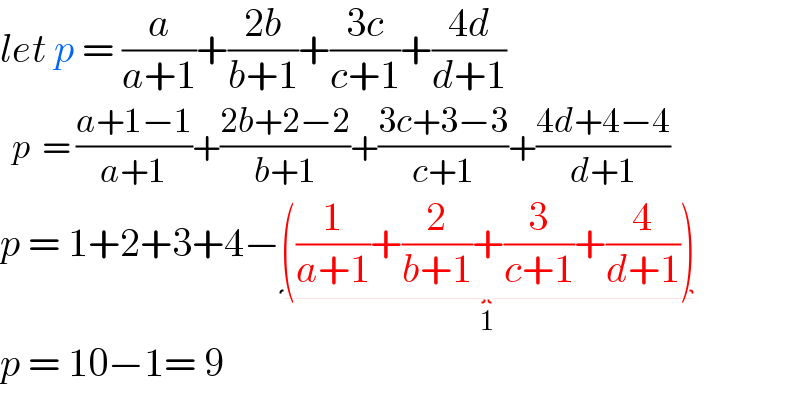
Question Number 196659 by sonukgindia last updated on 29/Aug/23

Commented by Rasheed.Sindhi last updated on 29/Aug/23

$${Too}\:{many}\:{questions}\:{per}\:{single}\:{post}! \\ $$
Commented by Rasheed.Sindhi last updated on 29/Aug/23

$${Q}#\mathrm{8} \\ $$$$\mathrm{2058000},\:\mathrm{2058343},\:\mathrm{2058686} \\ $$
Commented by deleteduser1 last updated on 29/Aug/23
![[V.9.]Last digit (−1)×1010+(1)×1010=0 (Ω/(10))≡(0/(10))≡0(mod 10)⇒Last two digits=00](Q196700.png)
$$\left[{V}.\mathrm{9}.\right]{Last}\:{digit}\:\left(−\mathrm{1}\right)×\mathrm{1010}+\left(\mathrm{1}\right)×\mathrm{1010}=\mathrm{0} \\ $$$$\frac{\Omega}{\mathrm{10}}\equiv\frac{\mathrm{0}}{\mathrm{10}}\equiv\mathrm{0}\left({mod}\:\mathrm{10}\right)\Rightarrow{Last}\:{two}\:{digits}=\mathrm{00} \\ $$
Commented by deleteduser1 last updated on 29/Aug/23
![[V.7.] Ω_1 −Ω_2 =(36^1 −25^1 )+(36^2 −25^2 )+...+(36^n −25^n ) 36^n −25^n ≡3^n −3^n ≡^(11) 0⇒Ω_1 −Ω_2 ≡^(11) 0](Q196701.png)
$$\left[{V}.\mathrm{7}.\right]\:\Omega_{\mathrm{1}} −\Omega_{\mathrm{2}} =\left(\mathrm{36}^{\mathrm{1}} −\mathrm{25}^{\mathrm{1}} \right)+\left(\mathrm{36}^{\mathrm{2}} −\mathrm{25}^{\mathrm{2}} \right)+...+\left(\mathrm{36}^{{n}} −\mathrm{25}^{{n}} \right) \\ $$$$\mathrm{36}^{{n}} −\mathrm{25}^{{n}} \equiv\mathrm{3}^{{n}} −\mathrm{3}^{{n}} \overset{\mathrm{11}} {\equiv}\mathrm{0}\Rightarrow\Omega_{\mathrm{1}} −\Omega_{\mathrm{2}} \overset{\mathrm{11}} {\equiv}\mathrm{0} \\ $$
Answered by Rasheed.Sindhi last updated on 29/Aug/23

$$\frac{\mathrm{1}}{{a}+\mathrm{1}}+\frac{\mathrm{2}}{{b}+\mathrm{1}}+\frac{\mathrm{3}}{{c}+\mathrm{1}}+\frac{\mathrm{4}}{{d}+\mathrm{1}}=\mathrm{1} \\ $$$$\frac{{a}}{{a}+\mathrm{1}}+\frac{\mathrm{2}{b}}{{b}+\mathrm{1}}+\frac{\mathrm{3}{c}}{{c}+\mathrm{1}}+\frac{\mathrm{4}{d}}{{d}+\mathrm{1}}=? \\ $$$$−.−.−.−.−.−.−.−.−.−.−.−.−.−.−.− \\ $$$$\blacktriangleright\frac{\mathrm{1}}{{a}+\mathrm{1}}+\mathrm{1}+\frac{\mathrm{2}}{{b}+\mathrm{1}}+\mathrm{2}+\frac{\mathrm{3}}{{c}+\mathrm{1}}+\mathrm{3}+\frac{\mathrm{4}}{{d}+\mathrm{1}}+\mathrm{4}=\mathrm{1}+\mathrm{10} \\ $$$$\blacktriangleright\frac{{a}+\mathrm{2}}{{a}+\mathrm{1}}+\frac{\mathrm{2}{b}+\mathrm{4}}{{b}+\mathrm{1}}+\frac{\mathrm{3}{c}+\mathrm{6}}{{c}+\mathrm{1}}+\frac{\mathrm{4}{d}+\mathrm{8}}{{d}+\mathrm{1}}=\mathrm{11} \\ $$$$\blacktriangleright\left(\frac{{a}}{{a}+\mathrm{1}}+\frac{\mathrm{2}}{{a}+\mathrm{1}}\right)+\left(\frac{\mathrm{2}{b}}{{b}+\mathrm{1}}+\frac{\mathrm{4}}{{b}+\mathrm{1}}\right) \\ $$$$\:\:\:\:\:+\left(\frac{\mathrm{3}{c}}{{c}+\mathrm{1}}+\frac{\mathrm{6}}{{c}+\mathrm{1}}\right)+\left(\frac{\mathrm{4}{d}}{{d}+\mathrm{1}}+\frac{\mathrm{8}}{{d}+\mathrm{1}}\right)=\mathrm{11} \\ $$$$\blacktriangleright\left(\frac{{a}}{{a}+\mathrm{1}}+\frac{\mathrm{2}{b}}{{b}+\mathrm{1}}+\frac{\mathrm{3}{c}}{{c}+\mathrm{1}}+\frac{\mathrm{4}{d}}{{d}+\mathrm{1}}\right) \\ $$$$\:\:\:\:\:\:\:\:\:+\left(\frac{\mathrm{2}}{{a}+\mathrm{1}}+\frac{\mathrm{4}}{{b}+\mathrm{1}}+\frac{\mathrm{6}}{{c}+\mathrm{1}}+\frac{\mathrm{8}}{{d}+\mathrm{1}}\right)=\mathrm{11} \\ $$$$\blacktriangleright\left(\frac{{a}}{{a}+\mathrm{1}}+\frac{\mathrm{2}{b}}{{b}+\mathrm{1}}+\frac{\mathrm{3}{c}}{{c}+\mathrm{1}}+\frac{\mathrm{4}{d}}{{d}+\mathrm{1}}\right) \\ $$$$\:\:\:\:\:\:\:+\mathrm{2}\left(\frac{\mathrm{1}}{{a}+\mathrm{1}}+\frac{\mathrm{2}}{{b}+\mathrm{1}}+\frac{\mathrm{3}}{{c}+\mathrm{1}}+\frac{\mathrm{4}}{{d}+\mathrm{1}}\right)=\mathrm{11} \\ $$$$\blacktriangleright\left(\frac{{a}}{{a}+\mathrm{1}}+\frac{\mathrm{2}{b}}{{b}+\mathrm{1}}+\frac{\mathrm{3}{c}}{{c}+\mathrm{1}}+\frac{\mathrm{4}{d}}{{d}+\mathrm{1}}\right) \\ $$$$\:\:\:\:\:\:\:\:\:\:\:\:\:\:\:\:\:\:\:\:\:\:\:\:\:+\mathrm{2}\left(\mathrm{1}\right)=\mathrm{11} \\ $$$$\blacktriangleright\frac{{a}}{{a}+\mathrm{1}}+\frac{\mathrm{2}{b}}{{b}+\mathrm{1}}+\frac{\mathrm{3}{c}}{{c}+\mathrm{1}}+\frac{\mathrm{4}{d}}{{d}+\mathrm{1}}=\mathrm{11}−\mathrm{2}=\mathrm{9}\checkmark \\ $$$$\: \\ $$
Commented by mnjuly1970 last updated on 29/Aug/23

$${a}=\mathrm{3}\:\:,\:{b}=\mathrm{7}\:,\:{c}=\mathrm{11},{d}=\mathrm{15} \\ $$$$\:\:\frac{\mathrm{3}}{\mathrm{4}\:}\:+\:\frac{\mathrm{7}}{\mathrm{4}}\:+\frac{\mathrm{11}}{\mathrm{4}}\:+\frac{\mathrm{15}}{\mathrm{4}}\:=\:\frac{\mathrm{36}}{\mathrm{4}}\:=\mathrm{9} \\ $$
Commented by Rasheed.Sindhi last updated on 29/Aug/23

$${mnjuly}\:{sir},\:{please}\:{share}\:{your} \\ $$$$\:{complete}\:{solution}. \\ $$
Answered by Rasheed.Sindhi last updated on 29/Aug/23

$${ab}+\mathrm{3}{a}−\mathrm{2}{b}=\mathrm{7} \\ $$$${ab}+\mathrm{3}{a}−\mathrm{2}{b}−\mathrm{6}=\mathrm{7}−\mathrm{6} \\ $$$${a}\left({b}+\mathrm{3}\right)−\mathrm{2}\left({b}+\mathrm{3}\right)=\mathrm{1} \\ $$$$\left({a}−\mathrm{2}\right)\left({b}+\mathrm{3}\right)=\mathrm{1}=\mathrm{1}×\mathrm{1}=−\mathrm{1}×−\mathrm{1} \\ $$$$\begin{cases}{{a}−\mathrm{2}=\mathrm{1}\:\wedge\:{b}+\mathrm{3}=\mathrm{1}\Rightarrow\left({a},{b}\right)=\left(\mathrm{3},−\mathrm{2}\right)}\\{{a}−\mathrm{2}=−\mathrm{1}\:\wedge\:{b}+\mathrm{3}=−\mathrm{1}\Rightarrow\left({a},{b}\right)=\left(\mathrm{1},−\mathrm{4}\right)}\end{cases} \\ $$
Answered by universe last updated on 29/Aug/23

$${let}\:{p}\:=\:\frac{{a}}{{a}+\mathrm{1}}+\frac{\mathrm{2}{b}}{{b}+\mathrm{1}}+\frac{\mathrm{3}{c}}{{c}+\mathrm{1}}+\frac{\mathrm{4}{d}}{{d}+\mathrm{1}} \\ $$$$\:\:{p}\:\:=\:\frac{{a}+\mathrm{1}−\mathrm{1}}{{a}+\mathrm{1}}+\frac{\mathrm{2}{b}+\mathrm{2}−\mathrm{2}}{{b}+\mathrm{1}}+\frac{\mathrm{3}{c}+\mathrm{3}−\mathrm{3}}{{c}+\mathrm{1}}+\frac{\mathrm{4}{d}+\mathrm{4}−\mathrm{4}}{{d}+\mathrm{1}} \\ $$$${p}\:=\:\mathrm{1}+\mathrm{2}+\mathrm{3}+\mathrm{4}−\underset{\mathrm{1}} {\underbrace{\left(\frac{\mathrm{1}}{{a}+\mathrm{1}}+\frac{\mathrm{2}}{{b}+\mathrm{1}}+\frac{\mathrm{3}}{{c}+\mathrm{1}}+\frac{\mathrm{4}}{{d}+\mathrm{1}}\right)}} \\ $$$${p}\:=\:\mathrm{10}−\mathrm{1}=\:\mathrm{9} \\ $$
Answered by Rasheed.Sindhi last updated on 29/Aug/23

$${Q}#\mathrm{6}\: \\ $$$$\Omega_{\mathrm{1}} +\Omega_{\mathrm{2}} =\mathrm{676}\:,\left(\Omega_{\mathrm{1}} ,\Omega_{\mathrm{2}} \right)=\mathrm{169} \\ $$$${Let}\:\Omega_{\mathrm{1}} =\mathrm{169}{m}\:\&\:\Omega_{\mathrm{2}} =\mathrm{169}{n},\:{where} \\ $$$$\left({m},{n}\right)=\mathrm{1} \\ $$$$\Omega_{\mathrm{1}} +\Omega_{\mathrm{2}} =\mathrm{169}{m}+\mathrm{169}{n}=\mathrm{676} \\ $$$${m}+{n}=\mathrm{4}\:\wedge\:\left({m},{n}\right)=\mathrm{1} \\ $$$$\left({m},{n}\right)=\left(\mathrm{1},\mathrm{3}\right),\left(\mathrm{3},\mathrm{1}\right) \\ $$$$\left(\Omega_{\mathrm{1}} ,\Omega_{\mathrm{2}} \right)=\left(\mathrm{1}×\mathrm{169},\mathrm{3}×\mathrm{169}\right),\left(\mathrm{3}×\mathrm{169},\mathrm{1}×\mathrm{169}\right) \\ $$$$\:\:\:\:\:\:\:\:\:\:\:\:\:\:\:\:=\left(\mathrm{169},\mathrm{507}\right),\left(\mathrm{507},\mathrm{169}\right) \\ $$$${Note}:{One}\:{of}\:{the}\:\mathrm{2}\:{figures}\left(\mathrm{876}\:\&\:\mathrm{169}\right)\:{is}\:{wrong}\:{at}\:{least}. \\ $$$${I}\:{have}\:{corrected}:\:\cancel{\overset{\mathrm{676}} {\mathrm{876}}}\:. \\ $$$$ \\ $$
Commented by Rasheed.Sindhi last updated on 29/Aug/23

$$\mathcal{N}{o}\:{hope}\:{of}\:{any}\:{type}\:{response}\:{from} \\ $$$${the}\:{questioner}!!! \\ $$
